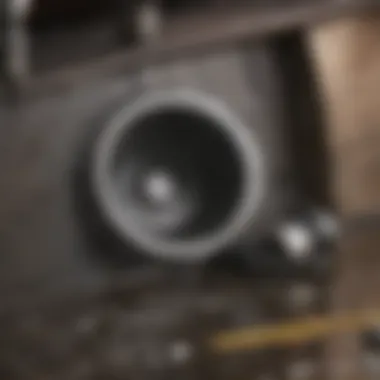Understanding Slow Drains in Garbage Disposals


Intro
Garbage disposals are a standard feature in many modern kitchens, offering convenience by allowing for quick disposal of food waste. However, homeowners often encounter the frustration of slow drains, which can significantly hinder the performance of these systems. Understanding the root causes of slow drainage can aid in both prevention and accurate troubleshooting. This article delves into essential aspects of garbage disposals, detailing maintenance techniques, examining common issues, and presenting effective solutions. The goal is to equip homeowners with the knowledge necessary for optimal disposal functionality.
Feature Spotlight
Efficient Mechanics of Garbage Disposals
Garbage disposals utilize a straightforward yet effective mechanism to break down food waste. They consist of a grind chamber, a flywheel, and a motor. Once food waste enters the grind chamber, the motor spins the flywheel at high speeds, chopping the waste into small particles. This process allows for easy passage through plumbing systems. However, when drainage slows, it often indicates underlying problems related to the mechanics of the unit.
Common Issues Leading to Slow Drains
Several factors can contribute to slow drainage in garbage disposals. These may include:
- Clogs caused by food particles: Over time, particles can accumulate and form blockages.
- Improper usage: Disposing of fibrous foods, bones, and starchy items can also contribute to drainage issues.
- Insufficient water flow: Not using enough water during the disposal process can lead to buildup.
Addressing these problems requires a basic understanding of what types of waste are suitable for disposal and the importance of running water during operation. By adhering to appropriate usage guidelines, homeowners can mitigate many common drainage problems.
Maintenance Tips
Regular maintenance is crucial for keeping garbage disposals functioning efficiently. Here are some practical tips:
- Run cold water: Always use cold water when running the disposal; hot water can melt grease and cause it to solidify and clog.
- Clean the unit: Periodically, grind ice cubes or citrus peels to clean the blades and eliminate odors.
- Inspect for leaks: Check pipes and connections regularly to ensure there are no leaks that might contribute to drainage problems.
- Avoid chemical cleaners: Harsh chemicals can damage the disposal; opt for natural cleaning methods instead.
Troubleshooting Slow Drains
When facing slow drains, first assess if any visible clogs exist. If problems persist, consider these steps:
- Check the power: Ensure that the unit is functioning and has power.
- Use a plunger: A simple plunger can dislodge minor blockages.
- Inspect the trap: Remove and check the trap for accumulated waste.
- Call a professional: If all else fails, consult an expert for deeper issues.
"A well-maintained garbage disposal can last up to 15 years, reducing the chances of inconvenient drainage problems."
Understanding the intricacies of garbage disposal systems is essential for optimal performance and longevity. By adopting proper usage habits and preventive measures, homeowners can avoid the common issue of slow drains, ensuring their kitchen remains functional and efficient.
Intro to Garbage Disposals
Garbage disposals play a vital role in modern kitchens by managing organic waste effectively. They not only help in keeping kitchens clean but also prevent unpleasant odors and pest issues connected with rotting food. Understanding how garbage disposals work and the common issues that arise, particularly slow draining, is essential for any homeowner. Without proper knowledge of these mechanics, users may inadvertently exacerbate problems that they could have easily avoided.
Definition and Purpose
A garbage disposal is an electrically powered device installed beneath a kitchen sink, designed to shred food waste into small pieces. This tiny size allows the waste to be easily washed away through the drainage system. The main purpose of a garbage disposal is to reduce the volume of food waste by grinding it, allowing for it to be disposed of through the home plumbing system rather than a landfill.
The convenience of using a garbage disposal cannot be overstated. Homeowners benefit from less clutter in bins, reduced smell, and the assurance that their food waste will be processed efficiently. This device contributes significantly to recycling and waste management efforts, as the ground food waste can be easier to compost or process in wastewater treatment facilities.
Mechanics of Operation
Garbage disposals operate through a simple mechanism. When food enters the disposal unit, it is ground by a series of sharp blades. These blades spin rapidly due to an electric motor. The conversion of food into small particles occurs as the blades chop and shred the waste, aided by the flow of water, which carries the small pieces into the drain.
The disposal unit typically comprises three main components: the grinding chamber, the motor, and the control switch. The grinding chamber is where the food waste is processed, while the motor powers the blades. The control switch enables the user to start and stop the process. Frequently, disposals come with an overload protector to prevent burn-out, which trips when too much resistance is detected in the grinding chamber.


In summary, understanding these mechanical operations is vital. If users are mindful of what goes into the disposal and how it works, they can avoid common issues like slow draining. Recognizing the importance of proper maintenance and operation can prolong the life of the unit and enhance its efficiency.
Common Reasons for Slow Draining
Understanding the common reasons for slow draining in garbage disposals is crucial for both maintaining the device and preventing costly repairs. A garbage disposal unit that drains slowly can disrupt daily activities in the kitchen and lead to aggravation. By identifying the factors contributing to this problem, homeowners can take proactive steps to address them efficiently. The primary issues often involve clogs, improper food disposal practices, pipe integrity, and water flow.
Clogs in the Drainage System
One of the most frequent reasons for a slow-draining garbage disposal is clogs in the drainage system. These clogs can develop from food particles, grease, or other debris accumulating in the pipes. When waste builds up, it restricts water flow and creates an obstruction, causing drains to function poorly. Homeowners should regularly inspect and clean their drainage systems, ensuring no buildup occurs.
An effective method to prevent clogs is to utilize a strainer in the sink. This small device helps catch large food particles before they enter the disposal. Additionally, periodic flushing of the system with hot water can help dissolve grease and keep lines clear.
Improper Food Disposal
Improper food disposal is another critical factor impacting drainage. Certain foods should not be placed in garbage disposals, as they can lead to blockages. Items such as fibrous vegetables (like celery), starchy foods (like pasta), and large bones can cause strain on the disposal unit.
Homeowners need to be mindful of what goes into the disposal. Educating family members about proper disposal techniques can minimize issues. For example:
- Chop large items into smaller pieces.
- Avoid putting fatty substances down the disposal.
- Dispose of hard items separately instead of using the disposal.
Pipe Issues
Pipe issues can also contribute to slow drainage. Over time, pipes can corrode, leak, or become misaligned due to various factors, including temperature fluctuations or sediment buildup. This deterioration can directly affect the efficiency of a garbage disposal system. If pipes are damaged, it could lead to restricted flow or even complete blockage, compromising the disposal's function.
Homeowners should consider inspecting their plumbing periodically, and if there are signs of wear, consult a plumbing expert for advice on repair or replacement.
Insufficient Water Flow
Lastly, insufficient water flow plays a significant role in slow draining situations. Water is essential for effectively operating a garbage disposal. When the water pressure is inadequate or the flow is inconsistent, it can lead to inefficient grinding and disposal of waste. It is recommended to run cold water when using the disposal, as hot water can melt grease that later solidifies, leading to clogs.
If water flow issues persist despite following these tips, homeowners may need to investigate further, checking faucets and ensuring there are no underlying plumbing problems. Regular maintenance of faucets and ensuring they are clean can significantly improve water flow, enhancing the overall performance of the disposal unit.
Remember, a well-maintained garbage disposal significantly reduces the chances of slow drains and encourages effective waste management.
Signs of a Slow Draining Garbage Disposal
Recognizing the signs of a slow draining garbage disposal is essential for homeowners. Early detection can prevent more significant plumbing issues and maintain the overall efficiency of the unit. Understanding the implications of these warning signs offers several benefits. For one, it encourages timely intervention, which can save both time and money. Additionally, being aware of these indicators helps maintain optimal kitchen hygiene, ultimately affecting the entire household's health. Here, we will detail three primary signs that indicate a garbage disposal may be struggling with drainage issues.
Unusual Sounds
When a garbage disposal starts making unusual sounds, it often suggests a problem that requires attention. Sounds such as grinding, rattling, or humming can indicate that something is obstructing the disposal's blades, or that food particles are not being adequately shredded. In some cases, these sounds may also suggest that the motor is under undue stress due to clogging or foreign objects. Homeowners should not ignore these noises, as they can signify wear and tear on the unit. Regularly monitoring sounds can lead to quicker fixes and enhance the overall longevity of the appliance.
Foul Odors
Foul odors emanating from a garbage disposal can be more than just unpleasant. They often signal the presence of decomposing food remnants within the system. When food particles get trapped and cannot drain properly, they begin to break down and emit smells, attracting pests and fostering bacteria growth. Maintaining good practices, such as flushing the disposal with cold water and using periodic cleaning methods, can help mitigate these odors. If the smells persist, it may indicate a more serious clog that requires professional intervention.
Water Backup
Water backup in the sink is one of the most alarming signs of a slow draining garbage disposal. When water does not drain as expected, it can quickly lead to more significant plumbing issues, such as overflow or flooding. This situation often arises from a blocked drain or an overloaded disposal unit. Homeowners should be vigilant and check for any backups, as they can culminate in costly repairs if addressed too late. Immediate action is crucial in these scenarios, as it can help avert extensive damage to plumbing systems.


Timely detection of these signs can lead to effective solutions and prevent more serious plumbing problems.
In summary, paying attention to unusual sounds, foul odors, and water backup can empower homeowners to act swiftly on slow draining garbage disposals. Each of these signs serves as a critical alert for maintenance needs, enabling users to sustain their garbage disposal systems effectively.
Maintenance Tips for Preventing Slow Drains
Maintaining a garbage disposal is essential for ensuring its efficiency and longevity. Preventing slow drains can save homeowners from frustration and unnecessary repair expenses. This section provides key strategies to keep the system functioning effectively. Regular maintenance addresses most common issues, decreasing the chances of complications down the line.
Regular Cleaning Practices
Regular cleaning is crucial for a garbage disposal. Food particles can build up, leading to poor performance. Start by running hot water for about 30 seconds before and after using the disposal. This helps flush any remaining debris through the system. Additionally, one can use a mixture of baking soda and vinegar as a natural cleaner. Pour a quarter cup of baking soda followed by a cup of vinegar down the disposal. Allow the concoction to fizz for a few minutes before rinsing with hot water. This simple practice can help remove odors and prevent clogs. Remember, maintaining cleanliness is not just about preventing slow drainage. It's about maintaining hygiene.
Proper Disposal Techniques
What you put down the disposal matters significantly. Certain foods should never be sent through the system. For instance, fibrous vegetables like celery can tangle in the blades. Similarly, starchy items such as pasta or rice can expand and cause clogs. To minimize issues, only dispose of soft food scraps and small bones that the unit can handle. Always chop larger items into smaller pieces. Educating your household about proper disposal techniques can significantly reduce the likelihood of future problems. This takes some extra effort but pays off in the long run.
Using Cold Water
Using cold water while the disposal is running is an often overlooked tip. Cold water solidifies any fats and oils, allowing them to be chopped finely and easily washed away. If hot water is used, it can cause these substances to liquefy and coat the sides of the pipes, promoting clogs. So, remember this simple detail: always run cold water before, during, and after using the disposal. It's a tedious habit, but it contributes significantly to the unit's performance and the plumbing system's integrity.
Proper maintenance techniques can help you avoid slow drains and prolong the life of your garbage disposal unit. Taking time to understand how to care for it is a worthwhile investment.
Troubleshooting Slow Draining Issues
When faced with slow draining issues in garbage disposals, it is essential to adopt a systematic approach to identify and resolve such problems effectively. This aspect of the article underscores the significance of proper troubleshooting. Knowing how to tackle drainage issues can prevent homeowners from extensive repairs and costly emergencies. A thorough understanding of this topic also enables efficient utilization of the disposal system, enhancing overall kitchen functionality.
Identifying the Source of the Problem
Recognizing the root cause of slow drainage is the first step in effective troubleshooting. Several factors could contribute to this issue, and discerning which one is at play is crucial. Common culprits include:
- Clogs in pipes or within the unit itself
- Improperly disposed food items that do not break down easily
- Aging or damaged pipes that restrict flow
- Insufficient water intake during the disposal process
To pinpoint the source, one can start by inspecting any visible plumbing, looking for obvious blockages. Itis advisable to run water and observe the rate of drainage. Noting the specific symptoms can guide one to the problematic area—be it the disposal unit, the sink drain, or the connecting pipes. Collecting this information simplifies further actions.
Using a Plunger
A plunger can often be a surprisingly effective tool for addressing slow drains in garbage disposals. While commonly associated with toilet issues, plungers can also help dislodge debris in sink drains. Here's how to use it properly:
- Gather Needed Tools: Ensure you have a suitable cup-shaped plunger designed for sinks.
- Seal the Drain: Block any overflow openings in the sink or adjacent drain to maximize suction. This can enhance your chances of dislodging the clog.
- Plunge Vigorously: Submerge the plunger in water, ensuring that it covers the drain opening. With firm, controlled motions, push and pull the plunger to create suction. This can help shift any debris blocking the pipes.
- Test the Drain: After a few minutes of plunging, check the drainage again. If effective, the water should flow more freely.
Be cautious not to apply excessive force, as this may damage plumbing components. If the problem persists, further investigation may be needed.
Checking the Disposal Unit
Inspecting the disposal unit itself is another essential step when troubleshooting. Here’s what you should do:
- Visual Inspection: Ensure the unit is properly installed and connected. Look for signs of leaks or obvious blockages on the exterior.
- Reset Button: Most disposals have a reset button located on the bottom. If the unit is humming but not spinning, pressing this button can resolve the issue.
- Internal Examination: If safe, look inside the disposal with a flashlight while ensuring it’s not powered on. Remove any visible obstruction. Do not use your hands; instead, rely on long-handled tools for removal.
- Testing Operation: After clearing obstructions, run cold water through the disposal and turn it on briefly to ensure it functions properly.
By performing these checks, homeowners can determine if the disposal unit is functioning correctly, which can lead to identifying whether the slow drainage problem lies elsewhere.


Key Takeaway: Effective troubleshooting of slow drains in garbage disposals is integral to maintaining functionality and avoiding costly repairs.
Professional Help: When to Call an Expert
When dealing with slow drains in garbage disposals, knowing when to call an expert can be crucial. While some issues can be resolved through basic maintenance and troubleshooting, others may require professional assistance. There are specific indicators that signify the necessity of expertise. Identifying these can prevent exacerbating the problem and potentially save costs in the long run.
Assessment of Severe Clogs
Severe clogs may not yield to standard methods of maintenance. In such cases, chocolatey black sludge might form, resulting in unpleasant odors and possible leaks. If household remedies like plungers, baking soda, or vinegar do not remedy the situation, it is time to consult a pro. A plumber can utilize specialized tools such as hydro jets or snake augers to effectively diagnose and address the problem.
Addressing Persistent Issues
Sometimes, slow drains persist even after multiple attempts at fixing them. Such problems can stem from more complex issues within the plumbing system. If drain problems recur frequently, understanding their root cause requires keen expertise. An experienced plumber can conduct a thorough investigation, pinpointing issues such as pipe misalignment or venting problems causing continual backups. Their knowledge aids in implementing long-term solutions rather than temporary fixes.
Routine Maintenance Services
Routine maintenance is essential for garbage disposal longevity. Professionals can offer regular inspections, cleaning, and maintenance services. These services ensure that potential issues are detected early, preventing sudden failures. Benefits of routine checks include optimizing performance, enhancing efficiency, and extending the life of the disposal unit. A simple schedule for expert evaluations can guard against unexpected mishaps and ensure smooth functioning for the disposal.
"Prevention is better than cure. Regular maintenance can save time and money in the long run."
The Impact of Home Design on Garbage Disposal Efficiency
The architectural layout and design of a kitchen can significantly influence the effectiveness and efficiency of garbage disposals. Understanding this aspect is crucial for homeowners, designers, and builders alike. A well-conceived kitchen space promotes optimal function, allowing disposals to work effectively under the right conditions. When the layout does not consider the necessary requirements, issues such as slow drainage can arise, leading to frustrations and potential plumbing problems.
Kitchen Layout Considerations
When planning a kitchen, the placement of the garbage disposal unit should be one of the priorities. Key elements to consider include:
- Proximity to the Sink: The garbage disposal should be situated directly beneath the sink. This placement allows food waste to be easily directed into the disposal, minimizing residue that can contribute to clogs.
- Counter Space: Sufficient counter space near the sink facilitates ease of food preparation and cleanup. Less clutter means less debris making its way into the drain.
- Flow Path: The design should promote efficient water flow towards the disposal. This may involve considering how pipes are installed and the angle at which they declinate. Any obstruction can increase the risk of slow drainage.
- Accessibility: The disposal unit should be easily accessible for maintenance. This includes being able to reach the unit for any potential repairs or cleaning, further enhancing its performance.
Overall, thoughtful kitchen design can prevent many drainage issues and enhance the longevity of the garbage disposal.
Choosing the Right Disposal Unit
Selecting a garbage disposal unit that matches the kitchen's design and use is essential. Here are several factors to keep in mind:
- Size and Power: Depending on the volume of food waste generated, choose a unit with appropriate power. Kitchen with high waste production requires more robust units.
- Noise Level: Many homeowners prefer quieter alternatives. Select models that offer noise insulation or lower decibel ratings.
- Grind Technology: Some disposals feature multiple grind stages to handle different types of food waste. Choose a unit that fits the types of items commonly disposed of.
- Ease of Installation: Make sure to select a unit that can fit well within your kitchen design. Compatibility with existing plumbing and ease of installation should be considered too.
In summary, home design plays a vital role in the efficiency of garbage disposals. Thoughtful kitchen layout and proper unit selection can greatly improve performance, preventing the occurrence of slow drains.
End
In concluding the discussion on slow drains in garbage disposals, it is essential to recognize the significance of maintaining these systems for optimal operation. Slow drainage is not simply a nuisance; it can lead to more severe plumbing issues if not addressed promptly. Understanding the root causes of this problem enables homeowners to take proactive measures. This article has highlighted various factors such as clogs, improper disposal methods, and the impact of home design on garbage disposal efficiency.
Recap of Key Points
- Common Causes: Clogs in the drainage system, improper food disposal, pipe issues, and insufficient water flow are major contributors to slow drains.
- Signs of Trouble: Paying attention to unusual sounds, foul odors, and signs of water backup can help in early identification of problems.
- Maintenance Tips: Regular cleaning practices and the use of proper disposal techniques are vital for successful maintenance.
- Troubleshooting: Simple actions, like using a plunger and checking the disposal unit, can mitigate minor issues.
- Professional Help: Knowing when to reach out to an expert ensures that severe problems are handled efficiently.
- Impact of Design: How the kitchen layout and the right disposal unit choice can enhance overall function.
The essence of this guide is to empower homeowners to make informed decisions about their garbage disposal systems. Simple actions yield significant results.
Encouragement for Ongoing Maintenance
Continuous maintenance is key to prolonging the life of your garbage disposal. Regular cleaning and proper utilization reduce the risk of slow drainage. Engaging with your disposal regularly ensures you are aware of its functional state. Adopting a mindset focused on maintenance will enhance your experience.
- Establish Routine Checks: Schedule regular checks to confirm the unit is in good working order.
- Incorporate Best Practices: Always follow proper food disposal techniques to minimize wear and tear.
- Invest in Professional Services: Consider routine maintenance services to prevent unexpected clogs or repairs.
By staying proactive and informed, homeowners can significantly alleviate the common challenges associated with garbage disposals. This means less frustration and smoother operation in the long run.







